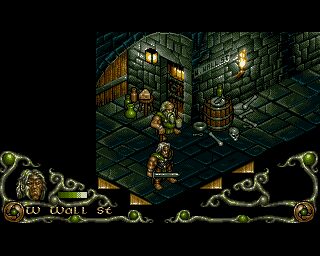Centauri Alliance is an RPG developed by Michael Cranford and released in 1990 for the Commodore 64 and Apple II. It is a science fiction role-playing game that carries the unmistakable influence of Cranford's earlier work on the celebrated The Bard's Tale series. However, instead of revisiting fantasy settings, Centauri Alliance boldly ventured into the realm of space exploration, offering a fresh take on party-based RPG mechanics.
Michael Cranford, who had been instrumental in designing The Bard’s Tale, applied much of the same structure to Centauri Alliance: players create a team of characters with different skills, explore labyrinthine environments, engage in turn-based combat, and gradually improve their party through experience. Yet despite these familiar foundations, Centauri Alliance distinguished itself in several important ways.
First, the game is set in a vast science fiction universe rather than a medieval fantasy world. The player's team is tasked with recovering stolen diplomatic documents vital to maintaining peace between planets. This premise allowed the game to introduce multiple alien races, high-tech weaponry, and varied planetary environments, which gave the gameplay a much different tone and flavor compared to the dungeon-crawling atmosphere of Cranford's earlier titles.
Technically, Centauri Alliance is quite advanced for its time, especially considering it was one of the last major RPGs for the aging Commodore 64 and Apple II platforms. The game featured large, detailed environments to explore, offering both indoor facilities and outdoor planetary surfaces. The sense of scale was impressive, and exploration played a much bigger role than in most RPGs of the era. The game's mechanics also included more complex skills and character statistics, providing players with deep customization and strategic options. On the Commodore 64, the game supported the mouse, a feature you can't find in many other C64 games.
One of the most innovative features was the flexible party system. Players could create characters belonging to various professions and alien species, each offering unique abilities, adding real tactical depth. Combat, while still turn-based, included more variables to manage, such as different types of terrain and environment hazards. The combination of exploration, dialogue, and combat made Centauri Alliance feel closer to a science fiction simulation than a pure dungeon crawler.
While Centauri Alliance was praised by players for its ambition and scope, it did not reach the same level of commercial success as The Bard’s Tale. By the time it was released, the Commodore 64 and Apple II were nearing the end of their market relevance, and the game’s complexity may have been intimidating for more casual players. Still, user reviews often praise it for being a technically impressive, richly detailed RPG that captured the imagination of those willing to invest the time to explore its universe.
Centauri Alliance remains a fascinating milestone in early RPG design — a title that dared to push the boundaries of its genre and platforms, even if it was ultimately a bit overlooked in its time. It stands today as a testament to Michael Cranford’s ability to innovate and expand the possibilities of role-playing games beyond traditional fantasy settings.













